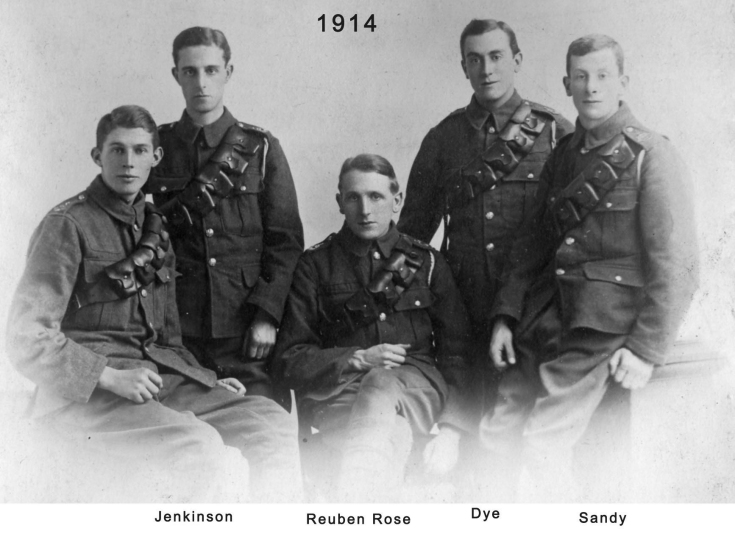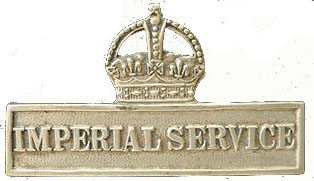
Reuben Rose enlisted into the British Army on 15th September 1914, just 6 weeks after the outbreak of war. He joined the Northumbrian (North Riding) Heavy Battery, Royal Garrison Artillery at their HQ Drill Hall at 53 Grange Road W, Middlesbrough. Much of the early recruitment in August and September 1914 took place at the Drill Hall, which was the base for many of the local Volunteer units, part of the Army’s Territorial Forces. There was also three units of Royal Engineers; a couple of companies of the Yorkshire Regiment and a squadron of the Yorkshire Hussars. This Drill Hall was pulled down some time ago, although at the other end of Grange Road there is still a similar drill hall.
As Reuben was an electrical engineer he could have been drawn to the Electric Light company of the Engineer’s, but decided on the Artillery. Perhaps he was already in this Territorial Force, which according to the local paper was already up to strength when they went on their annual camp in June. Looking at his nice new uniform he probably volunteered at the start of the war joining his best friend Sandy and other pals.
The North Riding Heavy Battery was part of the Northumbrian Division of the Territorial Force. In June 1914 the Battery had 5 officers and 180 men under the command of Captain T.D.H Stubbs. At the outbreak of war on 8th August they mobilised at Middlesbrough under the command of Major C.T. Hennah and moved to Monkseaton and then onto Newcastle upon Tyne on 1st September. They formed part of the coastal defences around Tynemouth. Reuben would have travelled to Newcastle soon after his enlistment where he volunteered for overseas duty, joining a new unit – 1/1st Northumbrian (NR) Heavy Battery. Those who prefered home duty formed the 2/1st NR Battery and stayed around Tynemouth providing the home defences during the war.  When men in the Territorial force agreed to overseas service they signed a “Imperial Service Obligation” and were issued a special badge, known as the “Imperial Service Brooch” worn on the right breast. As Reuben enlisted in September, he was expected to agree to overseas service and he is wearing his brooch on the 1915 Battery photo below.
When men in the Territorial force agreed to overseas service they signed a “Imperial Service Obligation” and were issued a special badge, known as the “Imperial Service Brooch” worn on the right breast. As Reuben enlisted in September, he was expected to agree to overseas service and he is wearing his brooch on the 1915 Battery photo below.

In Reubens unit photo above, there are 75 solidiers (including 8 NCO’s and 4 officers) so this is probably the full 1/1st Northumbrian (NR) Heavy Battery. This would be spring, (there are no leaves on the trees) so not long before they embarked for France. We can check the numbers by looking at the Medal Roll for the 1914-1915 Medal. At the end of the war all soldiers who fought overseas in 1914 or 1915 were given this award. The Northumbrian (North Riding) Heavy Battery RGA (TF) section of the medal roll shows that there were 82 individuals on dis-embarkation on 21st April 1915 (or joined a little later that year). By the end of the war, of this 82, 6 were Killed in Action, 7 Died of Wounds and 3 Died at home. They would have had a likely complement of 17 riding horses, 6 draught and 80 heavy draught horses with 3 two-horse carts and 10 four-horse wagons formed the battery.
At the outbreak of war, the North Riding battery was equipped with 4.7-inch Quick Fire (QF) guns supported by an attached Northumbrian (North Riding) Ammunition Column. They had two guns A, B along with a D sub-section at Middlesborough and one gun in C sub-section at Thornaby. These were previously naval guns converted to field guns for the Boer War with updated carriages (known as Mk I Woolwich). Overall, the heavy batteries of the Territorial forces had 92 QF 4.7 inch guns in France.

- British QF 4.7inch on 1900 Mk I “Woolwich” carriage,Western Front, World War I. AWM “Picardie, Somme Pozieres. Australian transport limbers returning down Sausage Valley gallop past a battery of British 4.7 inch quick firing (QF) field guns.”
After their seven month spell at Newcastle, the NRA RGA received their embarkation orders on 12th April 1915, boarding the train to embark and leave England on the 19th April. They landed at Le Havre on 21st April 1915, a date the Reuben remembered well, he refers to it on the first anniversary of his arrival in France in his 1916 diary. By the 23rd April the Northumbrian Division had concentrated in the area of Steenvoorde to the west of Ypres in Flanders. They had arrived just as the Second Battle of Ypres started with the Germans using poison gas for the first time. German infantry advanced across the Ypres salient, the Allied armies defensive area that had formed after the German invasion was halted in 1914. The Division was rushed into the battle moving up behind the Canadians (1st Canadian Division) who were taking the brunt of the German attack.
Here’s what was going on. “On the morning of 24 April, the Battle of St. Julien started with the Germans releasing another gas cloud towards the re-formed Canadian line just west of St. Julien. Word was passed to the troops to urinate on their handkerchiefs and place them over their nose and mouth. The countermeasures were insufficient, and German troops took the village. The next day the York and Durham Brigade units of the Northumberland Division counter-attacked, failing to secure their objectives but establishing a new line closer to the village. On 26 April the Northumberland Brigade attacked again and gained a foothold in the village, but were forced back with the loss of more than 1,940 casualties.”
It is likely that the NR Heavy Artillery was moved with the division, but they were not a mobile unit like the Field Artillery. Its possible a battery was set up to provide defensive cover to the Division fighting in the trenches some 5 miles away. They were probably located close to existing Heavy Artillery of the XIII Brigade RGA which was based to the west of Ypres close to Vlamertinghe.


This battle is was one of the first where superior German artillery came into play.  They hammered the Allied armies around Ypres, stopping them from making effective counter-attacks. German artillery, made up of a single 17-inch howitzer called Big Bertha along with accurate 8-inch and lighter guns, shelled Ypres town. Big Bertha fired shells weighing 1, 719lb (816kg). The shells were fired in pairs and, according to the British Official History, “travelled through the air with a noise like a runaway tramcar on badly laid rails”. This huge gun was located in the vicinity of the Houthulst Forest, north of Ypres.
They hammered the Allied armies around Ypres, stopping them from making effective counter-attacks. German artillery, made up of a single 17-inch howitzer called Big Bertha along with accurate 8-inch and lighter guns, shelled Ypres town. Big Bertha fired shells weighing 1, 719lb (816kg). The shells were fired in pairs and, according to the British Official History, “travelled through the air with a noise like a runaway tramcar on badly laid rails”. This huge gun was located in the vicinity of the Houthulst Forest, north of Ypres.
The British and Canadian Artillery with their old guns did figure prominently in the early battles, assigned to counter-battery fire trying to suppress the German fire. Unfortunately, reports from the time show that counter-battery fire failed. By the end of this battle, the barrels of some of the guns were so worn that bands were stripped off the shells at the muzzle as they were fired. Counter-battery fire failed due to the inaccuracy of the worn-out guns and the army still lacking means of accuratly locating enemy guns. Air observation and reporting along with using radios were in its early days.
Reuben would have know very little of this, the newly arrived battery would be busly engaged in setting up; building and settling into their billets; moving the ammunition around and getting the guns firing after the weeks travelling.
As artillery tactics developed during 1915, Batteries joined together, usually with three others, to form a Heavy Brigade. The brigade would have had their own Ammunition Column of around 100 OR troops and 3 officers. The ammunition was hauled around the Brigade by around 72 heavy horses in 16 four-horse wagons. Other transport was by 13 riding horses and 2 draught horses pulling a two-horse cart. An artillery Brigade HQ would also include 7 officers and 137 other ranks and their own riding, draught and heavy draught horses and wagons. Reubens 1916 diary often refers to going up to the Column, likely to be the Brigade ammunition stocks and other stores.
After the battle for St Julien was over on the 5th May, the North Riding RGA joined the newly formed XIII Brigade RGA. This artillery Brigade had been heavily involved in supporting the army during the early days of the Second Battle of Ypres. They joined other Heavy Batteries; the 2nd London Heavy Battery who had retreated some 5 miles back from Kitchener’s Wood loosing their guns (although these were subsequently recaptured), the 1st North Midland Heavy Battery who had recovered back from north of Wieltje and the 31st HB.
Almost immediately the Battle of Frezenberg started and the NR RGA were involved in shelling north of St Julien, counter shelling and suppressing the German artillery. More of the NR RGA action will be investigated as I go through the War Diary of the XIII brigade.
Sources:
- Reubens medal cards
- Wikipedia: 1st North Riding Artillery Volunteers.
- UK, WWI Service Medal and Award Rolls, 1914-1920 1914-1915 Star
- wikipedia.org/wiki/QF_4.7-inch_Gun_Mk_1
- North Eastern Daily Gazette – Saturday June 20 1914 (Size of the NR Heavy Battery)
- http://www.drillhalls.org/Counties/Yorkshire/TownMiddlesbrough.htm
- Kelly’s 1913 directory on Middlesbrough
- https://en.wikipedia.org/wiki/Second_Battle_of_Ypres
- http://www.greatwar.co.uk/battles/second-ypres-1915/prelude/big-bertha-bombards.htm
Leave a comment